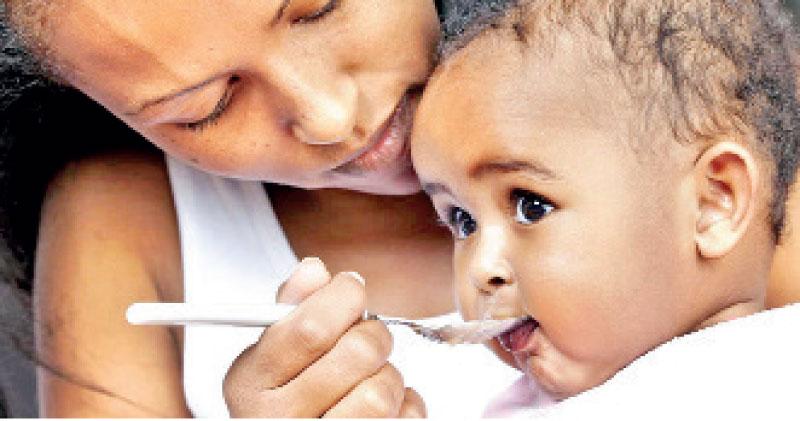11 Feb 2022 - {{hitsCtrl.values.hits}}

 While breast milk plays a crucial role as the sole source of food and nutrition since the day a baby is born, after a certain age, breast milk alone cannot fulfill the nutritional requirement for his/her growth. This is where the proper introduction of other sources of food, also called complementary feeding, comes into play. This is why we decided to discuss about complementary feeding, in today’s Health Capsule. Joining us is Dr. Maheshaka Wijayawardena, Consultant Paediatrician, Base Hospital Wathupitiwala.
While breast milk plays a crucial role as the sole source of food and nutrition since the day a baby is born, after a certain age, breast milk alone cannot fulfill the nutritional requirement for his/her growth. This is where the proper introduction of other sources of food, also called complementary feeding, comes into play. This is why we decided to discuss about complementary feeding, in today’s Health Capsule. Joining us is Dr. Maheshaka Wijayawardena, Consultant Paediatrician, Base Hospital Wathupitiwala.
Choosing the best time
A child is exclusively breast fed for the first six months of his life. Many mothers, especially first time mothers may need support with breastfeeding the baby at the beginning. Advises on breastfeeding can be sought from the Breast Feeding Management Center at your hospital and your Public Health Midwife.
World Health Organization recommends on starting complementary feeding after completion of 6 months. But depending on the requirements of the child, the paediatrician can decide to start complementary foods from 4 to 6 months.
Starting early weaning may depend on several factors such as inadequate weight gain of the child while on breast milk, and difficulty in breastfeeding in working mothers.
Starting on Complementary Feeding
In Sri Lanka weaning is usually started with rice porridge, initially mixed with breast milk to make a fine paste. Child can initially be fed a few teaspoonfuls a day, gradually increasing the amount.
Other food items such as dhal, vegetables, fruits, green leaves, fish/ dried fish, meat/ eggs can be slowly introduced. It’s recommended to introduce only one new food item per day. No salt and sugar should be added to the meals until the baby turns one year of age, due to the risk of dependence on the taste of sugar and salt later in life. After one week of starting complementary feeds, a small amount of coconut milk/ oil, can be added when preparing the food.
Mother can start with one or two complementary feeds per day, then gradually increase the number to three main meals and two snacks per day.
Babies, like adults, have individual food preferences. Therefore, it is important to try different food items and identify the baby’s likes and dislikes and prepare the food accordingly. This will improve the child’s interest in the meal, avoiding meal refusal.
Consistency of the meal too should gradually be increased, so that a child can have a normal adult meal with less spices by one year of age.
Breastfeeding while on complementary feeds
After the initial six months, breast milk alone is not enough to fulfill the energy and nutrition requirements of the growing child. Therefore, to make sure that the child is having an adequate meal, it is advised to avoid breastfeeding for two hours before a main meal, or the child could be too full to take the main meal. Child can be given breastfeeds in between meals and at night, on demand.
Breastfeeding can be continued until the child is around 1 ½ to 2 years. Benefits of breast milk to the child falls drastically after that as breast milk is unable to fulfill the nutritional requirements of the child, yet would leave the child too full for other, more nutrient rich meals. Therefore it’s best to gradually stop breastfeeding after child is 1 ½ to 2 years of age.
Problems encountered
Some children, if not properly weaned, can experience a drop in weight, which is noted in the weight Chart in the child health development record (CHDR).
A child having a satisfactory sleep following a meal, and passing adequate amount of urine and bowel movements is a good measure of the adequacy of the meal, in addition to the monthly weight gain.
If the child refuses meal, increase the variety of the meal and instead of trying to force feed the child frequently, which he would find stressful, try increasing the gap between the meals, so that the child is hungry and is willing to take the meal. Infections are another cause for weight drop in children. Soup, milk, jeewani, kanji and fruit juices are better alternatives than water to keep the child hydrated. After the child recovers from the illness, mother can add an extra meal for a few weeks to compensate for the weight loss.
 Healthy food habits
Healthy food habits
Cultivating healthy food habits in the child from the young age would be beneficial for his overall health throughout life. Having a designated place to feed the child, using utensils that are kept separate to feed, avoiding bottles and teats as much as possible, teaching and practicing proper hand washing techniques, feeding the child when hungry and avoiding forceful feeding are some of the good food habits that can be practiced at home.
Meal time is a time that the parents can utilize to engage with children. Research have found that even in very young children, increased interactions lead to better neuro-cognitive development. Therefore making meal time a family time whilst avoiding distractions like TV and internet would be beneficial for the child as well as the family unit.
03 May 2024 44 minute ago
03 May 2024 2 hours ago
03 May 2024 3 hours ago
03 May 2024 5 hours ago
03 May 2024 8 hours ago